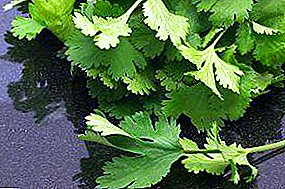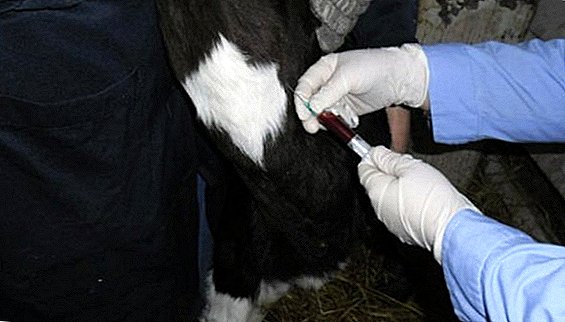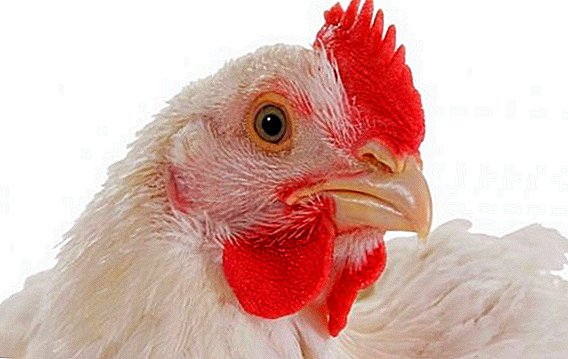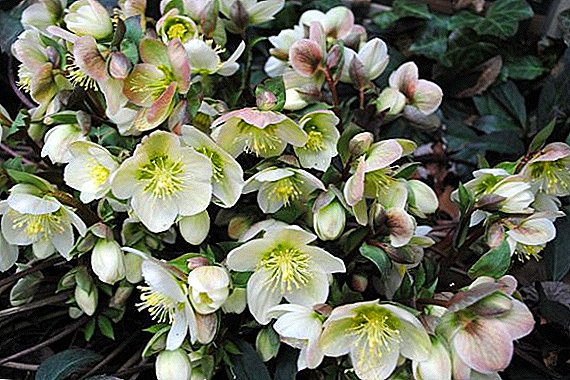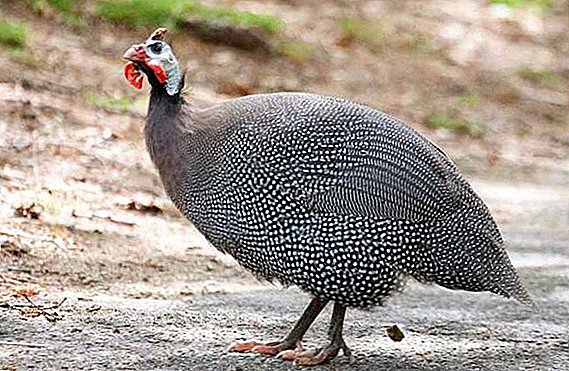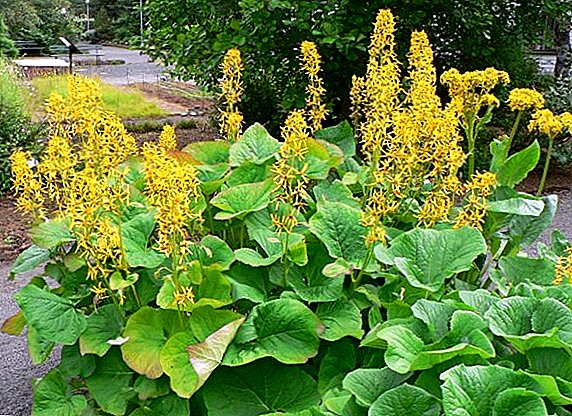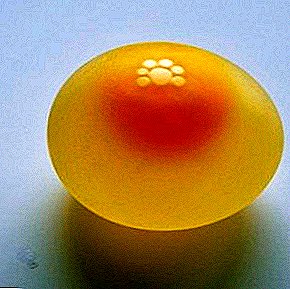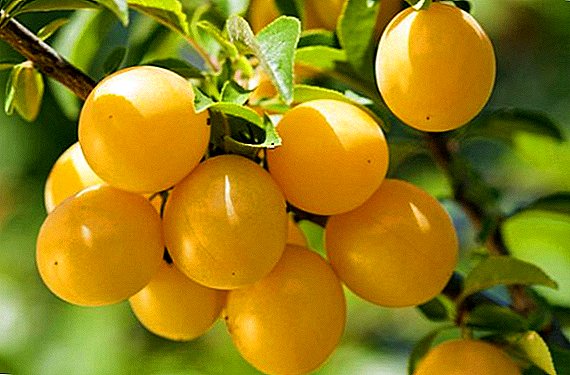 In a good garden there are always several types of plums. And this is not surprising, because people have grown this fruit for more than one hundred years. During this time, more than three hundred varieties of plum tree appeared. And not the last place in this series is the plum Mirabel.
In a good garden there are always several types of plums. And this is not surprising, because people have grown this fruit for more than one hundred years. During this time, more than three hundred varieties of plum tree appeared. And not the last place in this series is the plum Mirabel.
Botanical description
Mirabelle is a group of plum cultivars that grow on sredneroslye trees, having a root in the form of stem and grayish bark on the trunk and branches. The crown can be sprawling or ovoid depending on the variety. The leaves are in the shape of an ellipse, dark green in color, with a carved edge; there is an edge from the bottom.
The tree blooms in May. Each bud can have from 1 to 3 white flowers with a diameter of 1.5-2 cm. The flowers consist of 5 petals and bloom when there is no foliage yet. Fruits are round or oblong, medium-sized (up to 2 cm), yellow, reddish color is possible on the sunny side, ripen in August.
Important! Do not confuse plum Mirabel with cherry plum due to the fact that these fruits are very similar in appearance. To distinguish them, it is enough to break the plum in half and look at the bone. In a ripe mirabelle, the bone is perfectly separated from the pulp, while in all varieties of plum it is not, which is its biological feature..

Such a tree can live up to 25 years, and begins to bear fruit in the 4-5th year of life.
Spread
The homeland of this solar plum is Asia Minor. Today it grows in northern Africa, in southern Europe, especially in Germany and France. Mirabelle got to Ukraine and the middle part of Russia. And the richest crop is harvested in French Lorraine - about 15 thousand tons per season.
Did you know? Locals in Lorraine consider the Mirabelle plum to be its symbol. Every year in August, after the harvest, a whole celebration takes place, on which Miss Mirabel is chosen from the girls. And, of course, they cook traditional tart (open pie) using the collected fruits.
Nutritional value of fruits
The 100 g Mirabelle plum has a small amount of calories - only 40, but its nutritional properties are quite high. 
100 g of fruits contain:
- vegetable protein - 1 g;
- fats - 0.2 g;
- carbohydrates - 8.6 g
In addition, the nutritional value of this plum is in the presence of organic acids, mono - and disaccharides, fiber (dietary fiber), as well as in the presence of vitamins C and PP and minerals (potassium, calcium, phosphorus, sodium, magnesium, iron).
You will certainly be interested to read about the varieties of the best Chinese, self-fertile, columnar, yellow plums.
Varieties of varieties
Varieties of this wonderful plum displayed a large number. And we offer to your attention those that are most common among gardeners:
- "Yellow";

- "Big";
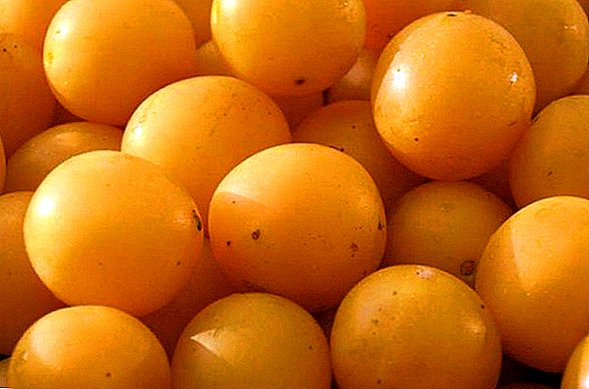
- "Small";

- "Bona";

- "September";

We recommend that you familiarize yourself with the agrotechnics of growing such varieties of plums as Morning, Honey White, Anna Shpet, Eurasia, and Stanley.
- "Nancy".
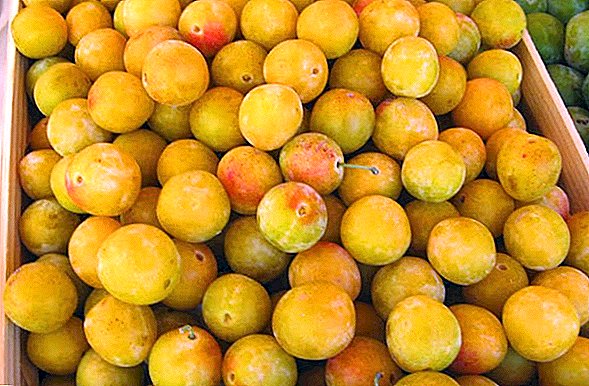
It should be noted that most often experienced gardeners plant a variety of "Nancy" on their land. They love it for the fact that the tree has increased frost resistance and gives decent yields every year.
Landing
If you have decided to plant Mirabelle plum in your plot, then it is not difficult to do so. Just need to know certain rules.
Choosing a place
The first step is to choose a place where the plum tree will be comfortable. Mirabelle will grow on any soil, with the exception of acidic.
Did you know? The easiest way to find out the acidity of the soil in your garden - use table vinegar. Put it on the earth and see the reaction. If bubbles appear, the soil is neutral, and if not - sour.

An important aspect is the occurrence of groundwater. They should be at least at a depth of 1.5 m. In addition, the place of future growth should be sunny, windless, the direction - south, south-west or west. And the distance to other nearby fruit trees should be 3-4 m.
Soil selection and preparation
Go to the next step. Dig to the depth of the shovel your chosen piece of land. As we have already noted, the soil for planting our plum should not be acidic. If, nevertheless, it is acidic, then it must be deoxidized. To do this, use dolomite flour or ash, it will be enough 600-800 g per 1 square. m
Now you need to prepare the landing pit. Its size is 70 × 70 cm, and its depth is 60 cm. When digging, the top layer of soil is set aside separately, since it is the most fertile and will be useful during planting. Next to the bottom of the excavated pit, you need to add fertilizer.  Consider the fact that if you have an autumn planting of a mirabel tree, then organic fertilizers (compost, peat, humus) will be enough in the amount of 3-4 kg, and if spring, add more complex mineral - 100 g of superphosphate and up to 80 g of potassium .
Consider the fact that if you have an autumn planting of a mirabel tree, then organic fertilizers (compost, peat, humus) will be enough in the amount of 3-4 kg, and if spring, add more complex mineral - 100 g of superphosphate and up to 80 g of potassium .
Important! Prepare a landing hole for planting our plums in advance, in two weeks. This will help improve the condition of the soil.
Landing process
The most difficult thing in planting a plum is to prepare the soil, everything else is not so difficult. When everything is ready for planting, take a sapling and lower it into a hole so that the grafting site remains above the ground. After that, fill the pit with earth without adding fertilizer.
In the end, it is necessary to water the tree planting site abundantly in order to provide plum suitable conditions for rooting and further growth. As for the planting dates, it is recommended to plant Mirabelle plum in the spring, for the reason that the young tree can not survive the winter frosts, if, of course, they are in your area.
Video: correct planting of seed stone seedlings The best time to plant in the spring is about 4-5 days after the snow has thawed. If, however, you decided to plant in autumn, then the seedling should be sloped with earth so that the snow cover completely covers it.
Care
Proper fit is half the battle. But, of course, if you want the planted tree to soon begin to please you with a regular and large crop, you need to follow certain rules of care, which we will now tell you about.
We advise you to familiarize yourself with the recipes of preparation of plums for the winter, as well as learn how to dry the plums at home and how to make plums compote and homemade plum wine.
Watering
Plum Mirabelle needs regular watering, not only in the summer, but also in the spring and autumn. The most optimal amount of watering is 1 time per month, but if a drought has occurred in your edges, then the intervals between watering need to be reduced, because the drain does not particularly favor the dry soil. 
Top dressing
Our plum is not particularly capricious in dressing, but it is still worth regularly fertilizing the soil. In the period from early spring to late autumn, the tree is fertilized with urea, using only 50 g of fertilizer per 10 liters of water. For one tree will be enough 2 liters of solution.
Feed in this order:
- the first top dressing is done after the tree has dissolved and began to enter the growing season;
- the second - after 2 weeks after the first;
- and the latest - the third, after another 2 weeks.
In the second year after planting, the growth and development of the root system can be stimulated artificially using foliar feedings. For these purposes, heteroauxin solution is most often used.
This is done for the reason that in the second year the tree can already begin to bear fruit, and in order for it to form good fruits, it needs a greater supply of nutrients from the soil, which provides a large root system.  When feeding in the spring and early summer, you can also include watering the tree with liquid manure. You can also use saltpeter in this dosage: 1 tablespoon to 1 bucket of water.
When feeding in the spring and early summer, you can also include watering the tree with liquid manure. You can also use saltpeter in this dosage: 1 tablespoon to 1 bucket of water.
Loosening and mulching
Loosening the near-wellbore should be done as needed. This will make the soil light and porous, which will ensure the flow of air to the root system of the tree. As mulch, peat is usually used to keep moisture longer.
Find out the answer to the question of how to grow plum out of a stone.During loosening, you should also remove all the weeds that grow next to the tree. They can not only pull the necessary nutrients, but also cause the development of various diseases, so the removal of weeds should become a regular ritual.
Pruning
Pruning this variety plums will not bring a lot of trouble, because the tree practically does not need pruning. But there are some points that should be mentioned. 
Important! Carefully ensure that the top is not damaged by winter frosts. If nothing is damaged, then only one shoot will develop from it, which will be a continuation of the conductor.
If the damage is still there, then the conductor will grow competitors in the form of 2-3 shoots. If they are not removed in time, the crown will develop incorrectly and take on the appearance of horns. Therefore, if you notice the presence of several shoots, then you need to select the most developed one and remove the rest.
Pruning Mirabelle can still be done in order to graft shoots to the rootstocks of other trees, including the usual plums. To do this, use the shoots of 15-20 cm.
Video: correct pruning
Preparing for the winter
At a young age, plum Mirabel is quite sensitive to frost, so you need to prepare it for winter with great care.
The best protection for the winter will be a combination of freshly fallen snow, as well as straw, hay or fir branches. Wrap the trunk and the area around it with snow and place the selected material on top. Such a construction will save the tree not only from low temperatures, but also from various rodents.
Familiarize yourself with the nuances of plum breeding, as well as proven methods of controlling diseases and pests.
Diseases and pests
The variety of plums described by us is not very susceptible to various pests and diseases. However, if the tree lacks nutrients, watering, or it has suffered from frost, then its stability can suffer greatly.
Mirabelle plum may be threatened by such diseases and pests:
- Plum moth. As the name implies, this pest eats the fruit of the tree and thereby significantly reduces the yield. The ways to combat this pest include digging up the soil and overlaying sacks of burlap around the trees.
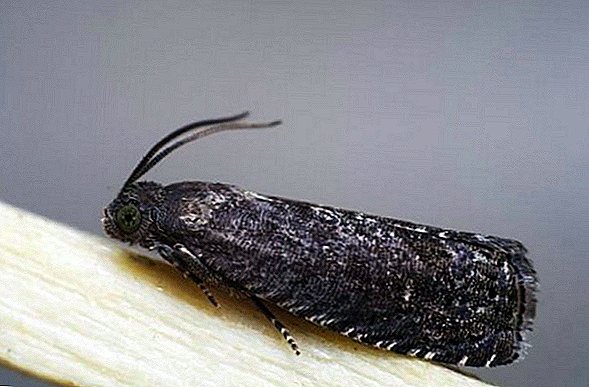
- Yellow plum sawfly. Like the previous pest, feeds on the fruits of plums. Get rid of it by digging up the soil and spraying the tree.
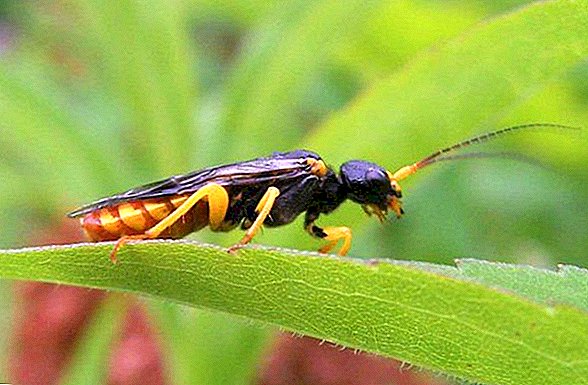
- Aphid. It settles mainly on the lower part of the leaves, because of what they lose color, the tree itself weakens, and the fruits do not survive and begin to rot. Fighting aphids is mainly spraying drugs such as nitrophene, benzophosphate and karbofos.
Familiarize yourself with how to deal with aphids and flap on plums.
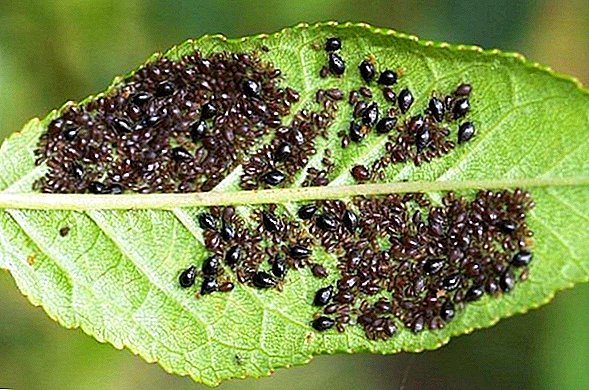
- Rosana leafworm. An insidious pest that damages the leaves by rolling them into a ball. After spoiling one part of the leaves, the leafworm quickly moves to another site. If the damage is not very large, then to get rid of this pest, you need to collect butterflies during the laying of eggs. At this time, it will be easy to do so for the reason that they do not fly, but crawl along the trunk. If the lesion has taken a large-scale spread, then spraying with nitrophene in the early spring will be effective.
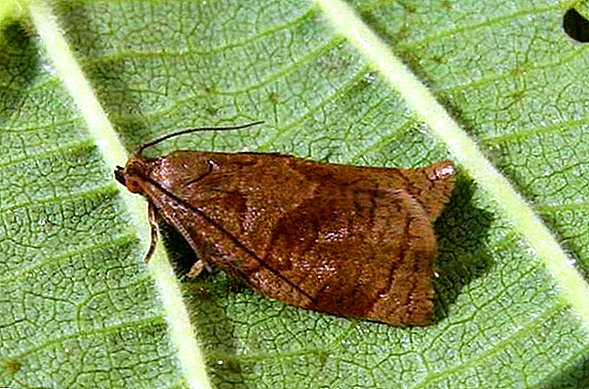
On this, our article came to an end. We hope that after reading it you will soon grow a wonderful tree, which will annually please you with not only tasty, but also very useful fruits. Grow on your plot more fruits and vegetables, because you will surely be confident in their usefulness. We wish you and your loved ones good health!










